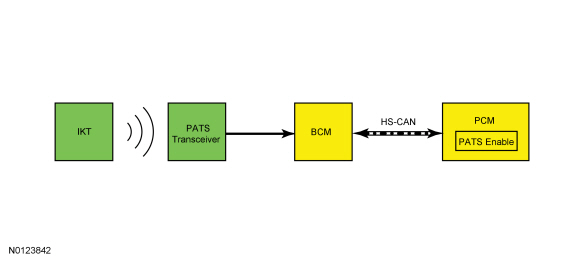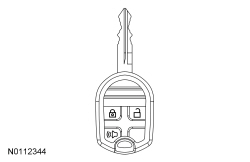SECTION 419-01B: Anti-Theft — Passive Anti-Theft System (PATS), Without Intelligent Access (IA)
| 2014 Flex Workshop Manual
|
DESCRIPTION AND OPERATION
| Procedure revision date: 05/02/2013
|
Overview
PATS deters the vehicle from theft by preventing the engine from starting unless a programmed PATS key is in the ignition. PATS does not disable an already running engine.
System Operation

Network Message Chart
PCM Network Input Messages
| Broadcast Message | Originating Module | Message Purpose |
|---|---|---|
| PATS start request target data | BCM | This is a request from the BCM for the PCM ID. The request is part of the PATS process of the BCM to check the PCM ID with the ID stored in the BCM . |
BCM Network Input Messages
| Broadcast Message | Originating Module | Message Purpose |
|---|---|---|
| PATS status enable/disable target data | PCM | This is a response from the PCM to the BCM request. The BCM compares the PCM ID to the ID stored within the BCM . If the PCM ID response is correct, the engine is allowed to start. |
Passive Anti-Theft System (PATS)
The PATS function is controlled by the BCM . There are 2 main checks that PATS performs before allowing the engine to start. If either of these checks fail, PATS does not allow the engine to start and STARTING SYSTEM FAULT displays in the message center. These 2 checks are the BCM verifying the PCM identification to make sure it matches the PCM identification stored in memory and to verify that a programmed key was used to change the ignition to RUN or START.
The first check is initiated by the BCM waking up the PCM by supplying voltage on the wakeup control circuit. The BCM only activates the wakeup circuit 5 times. After that, the wakeup circuit remains off until the ignition is cycled to RUN. The BCM activates the wakeup control circuit when any of the following occur:
Once the PCM is awake, the BCM sends the PCM a challenge message over the HS-CAN . When the PCM receives the challenge message, it generates a response and sends it back to the BCM . If the response from the PCM does not match the response in the BCM memory, this first check fails and the engine does not start.
Once the PCM identification has been verified, PATS performs the second check to make sure a programmed key is in the ignition key cylinder. When the BCM determines the ignition changes to RUN or START, it generates a challenge message. It sends the challenge message to the PATS transceiver on the transmit (TX) circuit. The transceiver in turn reads the key and generates a response message that is sent back to the BCM on the receive (RX) circuit. If the message received from the transceiver does not match a key stored in the BCM memory, the engine does not start.
If both the PCM identification and key verification pass, PATS allows the engine to start. PATS cannot disable or stall an engine that has already been started.
PATS PIDs
In conjunction with DTCs, the PATS PIDs are a useful tool when diagnosing PATS concerns.
BCM Module PID Chart
| Acronym | Name | Description |
|---|---|---|
| MIN_KEYS_RQD | Minimum number of keys required | Minimum number of programmed keys required. This PID always reads 2. |
| KEYS_PROGMD | PATS number of ignition key codes supported | Number of keys currently programmed into the BCM (If unlimited key mode is enabled, this PID only reads 2 regardless of how many keys are programmed). |
| START_ENABLD | Vehicle enable status | Indicates if PATS allows the engine to start. Must read enabled for the engine to start. |
| PCM_ID | PCM ID status stored | Indicates if there is a PCM identification currently stored in the BCM . Must read stored for the engine to start. |
| PCM_VERIFY | PCM verify OK | Indicates if the PCM identification received by the BCM matches the PCM identification stored in the BCM memory. Must read yes for the engine to start. |
| UNL_KEY_MODE | PATS unlimited key mode | Eight-digit unlimited transponder security key code that is selected by the customer. This can only be viewed while performing the unlimited key mode programming. |
Unlimited Key Mode
PATS contains a feature called unlimited key mode. This feature allows a customer to program more than 8 keys to their vehicle, if requested. Each vehicle in unlimited key mode is set up with a special unlimited transponder security key code. This allows all of the customer vehicles to share the same mechanically cut keys. For an individual customer, any randomly selected security key that has been previously mechanically cut and electronically programmed to the vehicle is acceptable. To enable/change the unlimited key mode, refer to Key Programming — Unlimited Key Mode .
When in the unlimited key mode, the KEYS_PROGMD PID in the BCM always reads 2, no matter how many keys are programmed to the vehicle (after the first 2 keys have been programmed to the vehicle).
Component Description
Integrated Keyhead Transmitter (IKT)
NOTE: The IKTs must have SA stamped on the keyblade. Conventional PATS keys must have HA or SA stamped on the keyblade.

The IKT incorporates both the PATS functions and the RKE transmitter functions in a single device.
During key programming procedures, the PATS and RKE transmitter of an IKT are both programmed into the BCM . Conventional PATS keys can also be programmed to the vehicle if requested by the customer.
Up to a maximum of 4 IKTs can be programmed. If more than 4 IKTs are programmed, INT KEY COULD NOT PROGRAM displays in the message center during the key programming procedure and the RKE functions of that IKT are inoperative.
Passive Anti-Theft System (PATS) Transceiver
The PATS transceiver reads any key that is placed in the ignition. When the ignition changes to ON or START, the BCM activates the PATS transceiver. Once the transceiver is activated, it in turn activates the key in the ignition and receives the key data. Once the transceiver receives the key data, it sends the data to the BCM .